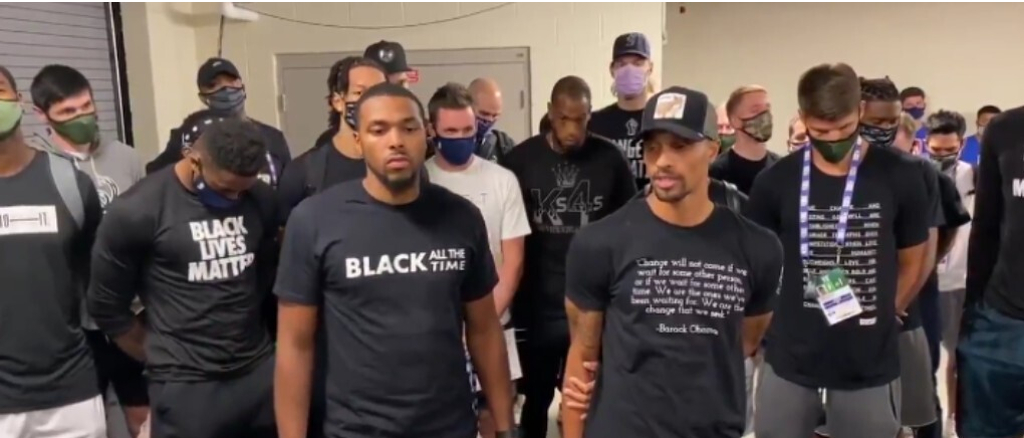The NBA is a star-driven league. Whether those stars are in actual or symbolic leadership positions, they exert enormous influence over the machinations of the league, be it free agency, the Draft, the collective bargaining agreement, or something else.
In the era of player empowerment, only now are they beginning to understand the full weight of what that means. It goes far beyond just exercising control over their financial destinies or which players they team up with. More and more, it’s begun to encompass a much larger sense of social responsibility. In 2020, that influence continued to spill over into the political sphere in a major way.
It wasn’t just the marquee stars who took to the front lines of the Black Lives Matter movement. Players at every level used their platform, their money, and their clout to lead social justice initiatives. And in one of the year’s biggest moments, it was a pair of lesser-heralded players on a small market team that helped orchestrate an unprecedented work stoppage in Orlando amid the ongoing police violence against Black Americans, forcing the NBA as an institution to take action.
This time around, it wasn’t anything so glamorous as LeBron James and company taking center stage at the ESPYs to call for an end to gun violence. In fact, the moment that left an indelible mark on the league this year happened in the most modest of settings: in the tunnel just outside the locker room, featuring Milwaukee Bucks players in their masks and warm-ups, issuing an historic call to action and condemning a system that has been allowed to act against its own people with impunity for far too long.
Even Giannis Antetokounmpo, the team’s most visible star, ceded the spotlight to NBA veteran George Hill, who delivered the statement alongside Sterling Brown explaining why the Bucks were refusing to play in Game 5 of their opening-round game against the Magic in Orlando.
The Milwaukee Bucks statement: pic.twitter.com/F7XOPs4NqE
— Malika Andrews (@malika_andrews) August 26, 2020
The Bucks statement, in print: “When we take the court and represent Milwaukee and Wisconsin, we are expected to play at a high level, give maximum effort and hold each other accountable… In this moment, we are demanding the same from our lawmakers and law enforcement.” pic.twitter.com/LrLKtsNvWs
— Malika Andrews (@malika_andrews) August 26, 2020
The Bucks were uniquely positioned to take the reins on the work stoppage, and not just because they play their home games less than an hour away from Kenosha, where the Jacob Blake shooting had recently shaken that community to its core. Brown himself had been a victim of police brutality just two years prior, when Milwaukee police tased and kneeled on him over a parking violation.
What was even more stunning about the Bucks’ decision was that it was made wholly independently. The rest of the league was free to respond however they wanted. The Magic, who were trailing 3-1 at the time, would’ve been within their right to take the forfeit. But, of course, that was never going to happen, and once they joined the Bucks in refusing to play, it caused a snowball effect, with the rest of the teams canceling their scheduled games for the night and subsequently throwing the remainder of the playoffs into doubt. It quickly spread to other sports leagues as well, as the WNBA and several MLB and MLS teams all postponed their scheduled games in a stunning show of solidarity.
It was a bold move, particularly the decision not to involve the players union or some of the other influential stars around the league. And to be sure, the Bucks’ unilateral decision muddied the path forward in the coming days. According to various reports, there were squabbles inside those marathon meetings in Orlando about what to do next, and shutting down the remainder of the season was very much, albeit briefly, in play.
Even before the work stoppage, Hill had expressed his regret about coming to the Bubble amid the widespread reports of police violence against Black people around the country and the widespread protests that had erupted in its wake. Many players echoed similar reservations about resuming play, before and after they arrived in Orlando. After the walkout, the question had been raised again: Was it better to use their platform via the NBA to bring awareness and change, or would their efforts be better served back home in their respective communities?
Ultimately, staying won out, in no small part because of the financial implications on a league that was already hemorrhaging money during to the pandemic. But not before the players had demonstrated the full capacity of their power in a way we’ve never seen. Despite the chaos that followed over the next 48 hours, they were able to meet all of their goals: resuming the playoffs, bringing the game back to fans, and putting pressure on the league to take tangible action in the fight for equal justice.

The result was the creation of the NBA’s Social Justice Coalition, which focuses on voting rights, education, civic engagement, criminal justice reform, and more. It also looked to expand the use of team-owned arenas as voting locations in the November election, a plan that was already underway in several cities and would arguably go on to impact the election in some key states — according to USA Today, nearly 300,000 people voted at sporting arenas across the country on November 3, and no stadium saw a bigger turnout than the Hawks’ State Farm Arena in Atlanta, where approximately 40,000 people cast their ballots in a state that ended up helping Democratic president-elect Joe Biden carry Georgia.
But the Bucks’ initial refusal to play was only partly aimed at forcing the league to take action. The more immediate target was the Wisconsin State Legislature. After the walk-out, the team got on the phone with Wisconsin Attorney General Josh Kaul and Lieutenant Governor Mandela Barnes. Together, they clarified the phrasing of their demands to apply pressure to the Republican-led legislature for their inaction during months of civil unrest and a deadly virus that was spreading rapidly.
Since then, several Bucks players have spoken about the emotions and the intensity surrounding their decision and its immediate aftermath. Kyle Korver described the atmosphere inside the Bucks locker room prior to their bombshell announcement and what it was like watching assistant coach Darvin Ham, a father, openly reckon with the possibility that his son could be murdered by police without provocation or repercussion.
Korver also confirmed that it was indeed Hill and Brown who took the lead and first told their teammates that they would refuse to play and, more so, that they were willing to go it alone without putting pressure on the rest of the guys to join them. By all accounts, it wasn’t a premeditated act. Hill and Brown didn’t arrive at their decision until about 45 minutes before the scheduled tip-off and hadn’t communicated their intention with the Magic, the referees, the players’ union, or league officials. Bucks owner Marc Lasry didn’t even know about it until just before they notified game officials.
The whole thing didn’t just signal a new level of social and cultural engagement for the NBA and its players. It demonstrated the sheer power of an individual who is willing to stand on principle. In doing so, George Hill and Sterling Brown reminded us what real leadership looks like. They reminded us that it doesn’t have to come from the top, and it doesn’t have to come by committee. In a time where apathy and cynicism threaten to undermine the fight for equal justice, we’d do well to remember what even a single person is capable of.







